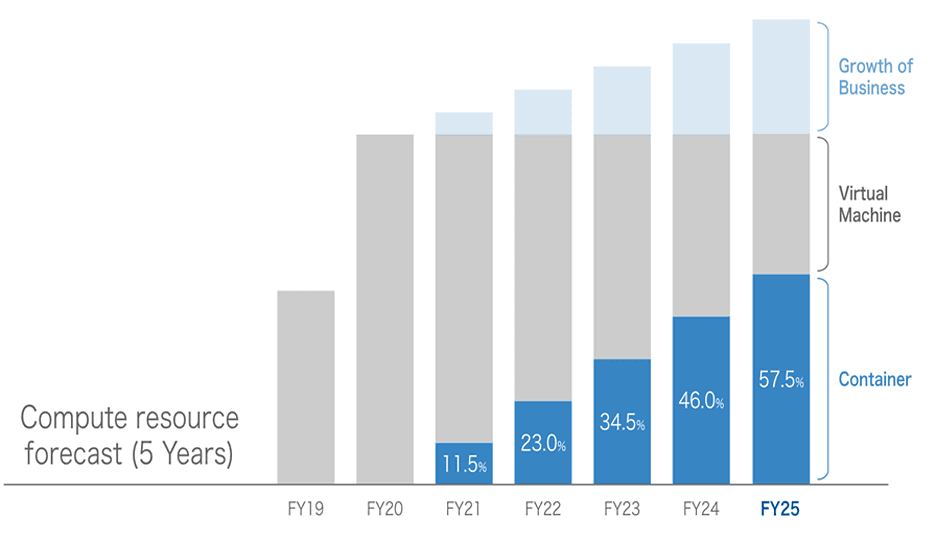SoftBank Corp. (TOKYO: 9434) provides telecommunications services and combines them with advanced technologies to develop and operate new businesses in Japan and globally. SoftBank Corp. has 56 million mobile and broadband subscribers in Japan. The Corporate Information Technology Division of SoftBank Corp. decided it needed to improve the low resource utilization and other inefficiencies of its private, virtualized infrastructure. But the global company had a predicament—its security requirements mandated on-premises deployment with an option for possible future public-cloud capabilities. It sought a way to bring the effectiveness of cloud-native microservices and containers to its private data center and turned to F5 Distributed Cloud Services.
The Corporate Information Technology Division of SoftBank Corp. manages an IT infrastructure consisting of more than 800 types of systems, more than 20,000 servers, and more than 20,000 switches. Also, the number of servers is increasing by several hundred every month.
This corporation has traditionally built infrastructure based on virtual machines (VMs) and monolithic systems, which was ideal for workloads of a similar size; however, the size and complexity of workloads have changed dramatically with time. As for resource design, since the company provided resources sufficient to withstand busy periods, such resources cannot be used effectively during slack periods, which meant the overall resource usage rate was very low, with the usage rate of CPUs for 1,500 or more servers at 10% or less and their memory usage rate at 50% or less. This meant a significant cost increase, and the inability to manage the entire infrastructure resulted in other inefficiencies.
SoftBank's IT Infrastructure Division thought that adopting a microservices-based architecture using a virtual container system would significantly improve the usage rate and flexibility of resources, enabling many more workloads to be handled at significantly lower cost. However, it was necessary to integrate these cloud-native innovations into the company's current private environment. This meant that it was necessary to reduce the number of VMs by migrating workloads to containers, and eventually replace them over time.
Another challenge faced by the company was that with the addition of new in-house systems, the application department had to spend time on their implementation. As SoftBank Corp. has provided services to various industries such as technology, mobile, the Internet, energy, and business, it has frequently added new in-house systems.
The IT Infrastructure Division thought that it would be possible to resolve this by providing self-service options using cloud-native microservices to simplify the development of infrastructure to which in-house systems were frequently added.
Also, SoftBank wanted to reduce the overall IT load so that employees would be able to concentrate on their core business. Allowing F5 Distributed Cloud Services to manage the infrastructure and update or upgrade the platform is expected to improve the company's IT operational efficiency.
SoftBank technically validated three solutions, F5 Distributed Cloud Services and two competing solutions (both of which are from major infrastructure brands), to solve this IT infrastructure challenge and win the business. As a result of the commercial use screening conducted in 2020, F5 Distributed Cloud App Stack and F5 Distributed Cloud Mesh were selected. This means that Distributed Cloud Services were entrusted with the cloud-nativization and protection of the private environment of one of the world's most influential companies' IT infrastructure.
The IT Infrastructure Division expects that using Distributed Cloud App Stack solutions will improve the resource usage rate and overall efficiency of its private infrastructure. SoftBank plans to achieve low latency and high security in both the application and network layers within and between clusters through adding Distributed Cloud Mesh.
The Distributed Cloud App Stack platform was selected as the best solution for the following reasons:
Distributed Cloud Mesh delivers distributed application networking and security services as part of the solution with Distributed Cloud App Stack, and the integrated capability of the technologies influenced the company to select Distributed Cloud Services.
Distributed Cloud Services were selected as the best solution among the competitors for the following reasons:
Compared to one of the competitors, Distributed Cloud Services proved to have more abundant network functions, including one that facilitates the scaling of external network connections, and they did not require integration with third-party software; thus, Distributed Cloud Services show excellent velocity from build-up to operation.
Distributed Cloud Services work with the CI/CD (continuous integration/continuous delivery) process prepared by SoftBank to streamline workloads by eliminating the need for developers to wait for their apps to be deployed. Also, using managed Kubernetes, the Application Development Department can execute its original applications and microservices deployment on a self-service basis.
Since Distributed Cloud App Stack is fully integrated with Distributed Cloud Mesh, instead of individually requesting a network, security, and policies from the IT Infrastructure Division each time there is a new requirement, the Application Development Department can introduce an Infrastructure-as-Code type network configuration to the private cloud by itself, while automatically applying security at layers 3-7.
This infrastructure change has been scheduled in SoftBank's investment forecast for 2022 to 2025, and increasing investment in new container units and spending less on virtual machines are included in its plans. The forecast predicts that the share of container units will increase from zero to 60% by 2025.

By using these new containers, the company plans to launch two major new applications that enable more sales and smoother transactions, both in brick-and-mortar stores and on online portal sites, and Distributed Cloud Services will play a key role in the success of these two applications.
Lastly, although being subject to highly robust security requirements, the corporation is seeking to take advantage of public cloud capabilities for specific applications, such as disaster recovery, in the future.
